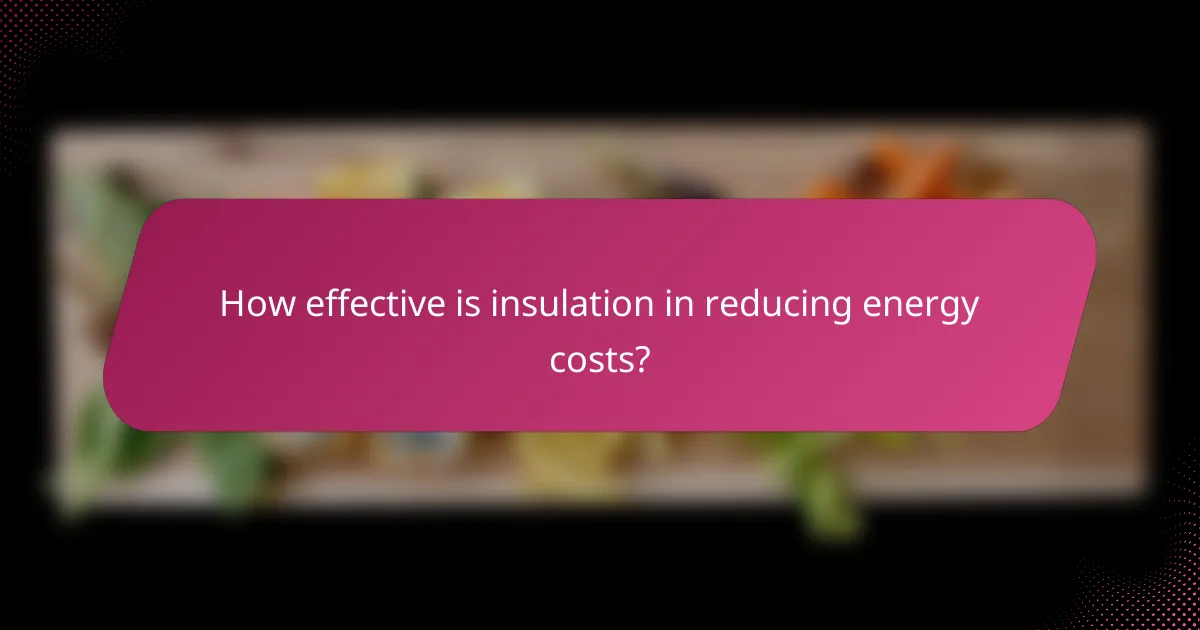In Los Angeles, homeowners have access to a variety of insulation options, each offering distinct advantages for energy efficiency. Common types such as fiberglass, foam board, cellulose, mineral wool, and spray foam can significantly reduce energy costs by minimizing heat transfer. The effectiveness of these materials depends on factors like R-value, installation quality, and local climate, making it essential to choose the right insulation for optimal savings.

What insulation options are available in Los Angeles?
In Los Angeles, homeowners can choose from various insulation options, each with unique benefits and considerations. The most common types include fiberglass, foam board, cellulose, mineral wool, and spray foam insulation, all of which can significantly enhance energy efficiency.
Fiberglass insulation
Fiberglass insulation consists of tiny glass fibers and is widely used due to its affordability and effectiveness. It is available in batts, rolls, and loose-fill forms, making it versatile for different applications, including attics and walls.
When installing fiberglass, ensure proper sealing to avoid air leaks, which can undermine its effectiveness. It typically offers an R-value ranging from 2.9 to 4.3 per inch, making it a solid choice for energy savings.
Foam board insulation
Foam board insulation is a rigid panel made from polystyrene or polyisocyanurate, providing high thermal resistance. It is ideal for exterior walls, foundations, and roofs, where space is limited.
This type of insulation can achieve R-values between 4 and 6.5 per inch, making it highly effective. When using foam board, ensure it is properly sealed to prevent moisture accumulation, which can lead to mold growth.
Cellulose insulation
Cellulose insulation is made from recycled paper products and is treated for fire resistance. It is often installed as loose-fill, making it suitable for retrofitting existing structures.
With an R-value of approximately 3.1 to 3.8 per inch, cellulose is an eco-friendly option that also provides good soundproofing. Be cautious of settling over time, which can reduce its effectiveness, and consider professional installation for optimal results.
Mineral wool insulation
Mineral wool insulation, also known as rock wool, is made from natural or recycled materials and offers excellent fire resistance and soundproofing. It is moisture-resistant, making it suitable for areas prone to dampness.
This insulation type typically has an R-value of around 3.1 to 4.4 per inch. When installing mineral wool, ensure it fits snugly in cavities to maximize its insulating properties and prevent air leaks.
Spray foam insulation
Spray foam insulation is a versatile option that expands upon application, creating an airtight seal. It is available in open-cell and closed-cell varieties, with closed-cell offering higher R-values and moisture resistance.
With R-values ranging from 3.6 to 6.5 per inch, spray foam is highly effective for energy savings. However, it requires professional installation due to its complexity and potential health risks during application, so consider hiring certified contractors in Los Angeles.

How effective is insulation in reducing energy costs?
Insulation is highly effective in reducing energy costs by minimizing heat transfer between the interior and exterior of a building. Properly installed insulation can lead to significant savings on heating and cooling bills, often reducing energy consumption by a considerable percentage.
Improves energy efficiency
Insulation enhances energy efficiency by creating a barrier that slows the flow of heat. In colder months, it keeps warm air inside, while in warmer months, it prevents heat from entering. This efficiency not only lowers energy usage but also contributes to a more comfortable living environment.
Common insulation materials include fiberglass, foam board, and spray foam, each with different R-values, which measure thermal resistance. Higher R-values indicate better insulation performance, so selecting materials with appropriate R-values for your climate zone is crucial.
Reduces heating and cooling expenses
By improving energy efficiency, insulation directly reduces heating and cooling expenses. Homeowners can expect savings ranging from 10% to 50% on their energy bills, depending on the type and quality of insulation used.
For instance, adding insulation to attics and walls can yield the most significant savings. Regularly checking for gaps or areas of inadequate insulation can help maintain these savings over time. Consider consulting with a professional to assess your insulation needs and ensure optimal installation.

What factors influence insulation effectiveness?
The effectiveness of insulation is influenced by several key factors, including R-value, installation quality, and climate considerations. Understanding these elements can help you make informed decisions about insulation materials and methods for your home.
R-value of insulation
R-value measures the thermal resistance of insulation materials; higher R-values indicate better insulating properties. For residential applications, R-values typically range from about R-13 for walls to R-38 for attics, depending on the climate zone.
When selecting insulation, consider the recommended R-value for your specific area. For example, colder regions may require higher R-values to maintain energy efficiency and comfort.
Installation quality
The quality of insulation installation significantly impacts its effectiveness. Poorly installed insulation can lead to gaps, compression, and thermal bridging, which reduce its ability to resist heat flow.
To ensure proper installation, follow manufacturer guidelines and consider hiring a professional. Inspect the work to confirm there are no visible gaps or areas where insulation is missing.
Climate considerations
Your local climate plays a crucial role in determining the best insulation type and R-value for your home. In warmer climates, reflective insulation may be more beneficial, while colder areas typically require materials with higher R-values.
Evaluate your region’s climate zone and seasonal temperature variations to choose insulation that optimizes energy savings. For instance, homes in regions with extreme temperature fluctuations may need a combination of insulation types for maximum efficiency.

How to choose the right insulation for your home?
Choosing the right insulation for your home involves understanding your local climate, building codes, and energy efficiency goals. Consider factors such as insulation type, R-value, and environmental impact to make an informed decision that enhances comfort and reduces energy costs.
Assessing local building codes
Local building codes dictate the minimum insulation requirements for homes, which vary by region. Check with your local authority to understand the specific R-values needed for different areas of your home, such as attics, walls, and basements.
Compliance with these codes ensures not only safety but also optimal energy efficiency. For instance, homes in colder climates may require higher R-values compared to those in warmer regions.
Evaluating home energy audits
A home energy audit identifies areas where insulation can improve energy efficiency. During an audit, professionals assess your home’s current insulation levels, air leaks, and overall energy performance.
Utilizing the findings from an energy audit can guide your insulation choices, helping you prioritize areas that will yield the most significant energy savings. Many utility companies offer incentives or rebates for homeowners who complete energy audits and make recommended improvements.
Considering environmental impact
When selecting insulation, consider its environmental impact, including production methods and recyclability. Materials like cellulose or sheep’s wool are often more sustainable options compared to traditional fiberglass or foam insulations.
Additionally, look for insulation products with low VOC emissions to improve indoor air quality. Certifications such as Energy Star or GreenGuard can help identify environmentally friendly options that align with your sustainability goals.

What are the costs associated with insulation installation?
The costs of insulation installation can vary significantly based on the type of insulation, the size of the area being insulated, and local labor rates. Homeowners should expect to invest in both materials and labor, which together can range from a few hundred to several thousand dollars depending on the specifics of the project.
Average pricing for materials
Insulation materials come in various types, each with its own price range. For example, fiberglass batts typically cost between $0.50 to $2.00 per square foot, while spray foam insulation can range from $1.00 to $3.00 per square foot. Cellulose insulation generally falls in the $0.70 to $2.00 per square foot range.
When selecting insulation, consider not only the initial cost but also the long-term energy savings. Higher upfront costs for materials like spray foam may lead to greater energy efficiency and lower utility bills over time.
Labor costs in Los Angeles
Labor costs for insulation installation in Los Angeles can vary widely, typically ranging from $50 to $100 per hour. The total labor expense will depend on the complexity of the job and the experience of the contractor. For a standard installation, homeowners might expect to pay between $1.00 and $2.50 per square foot for labor.
It’s advisable to obtain multiple quotes from local contractors to ensure competitive pricing. Additionally, check for any licensing requirements or regulations specific to Los Angeles that may impact installation costs.


